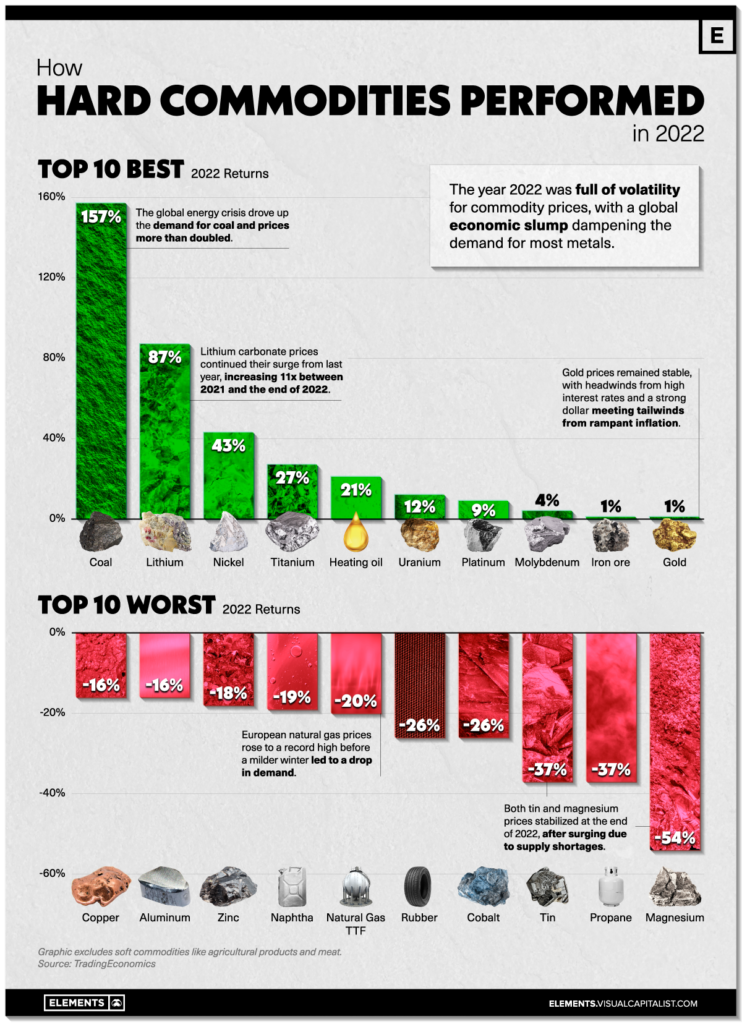
Hard commodities had a roller coaster year in 2022.
While prices for some commodities stabilized after skyrocketing on the heels of the pandemic, others delivered stellar returns. Behind the volatility was a plethora of factors, including the Russia-Ukraine war, the global economic slump, and a drop in China’s demand for materials.
This chart uses price data from TradingEconomics to highlight the 10 best and worst performing hard commodities of 2022. It excludes soft commodities like agricultural products and meat.
The global economic rebound of 2021, which set the fastest post-recession growth pace in the last 80 years, sparked coal prices as energy demand increased. Russia’s invasion of Ukraine ignited the spark, with coal prices exploding 157% in 2022.
Consequently, coal was the best performing commodity in 2022, far outperforming the other nine top commodities by returns.

Lithium (carbonate) and nickel prices continue to be supercharged by the demand for EVs and batteries. Since the beginning of 2021, lithium prices have increased 11-fold, and remain elevated at more than $70,000 per tonne.
As a result of high prices for lithium, nickel, and other battery metals, the average cost of lithium-ion battery packs increased in 2022, for the first time since 2010. Battery pack prices are expected to increase in 2023 as well, before falling in 2024.
The year was also positive for uranium as countries revived their nuclear power plans to combat the energy crunch. Notably, Germany extended the lifetime of three plants that were set to shut down in 2022, and Japan announced accelerated restarts for several idle reactors.
Crude oil is by far the biggest commodity market, and oil prices were the talk of the town for much of 2022.
Following Russia’s invasion of Ukraine, WTI crude oil prices rose to their highest level since 2013 by May 2022. However, between June and the end of December, prices fell from around $116 per barrel to $80 per barrel (a 31% fall). Overall, in 2022, crude oil delivered a -3% return.
The erasure of oil’s initial gains can be attributed to the slowdown in economic growth globally, in addition to strict COVID-19 lockdowns in China.
The negative returns for most commodities can be largely attributed to prices stabilizing at lower levels after bullish runs in 2021 and the beginning of 2022.

For example, magnesium prices more than halved in 2022, declining from an all-time high in September 2021. Similarly, tin prices also normalized after rising due to unprecedented demand from the electronics sector during the economic rebound from the pandemic.
The volatility in European natural gas (TTF gas) was one of the highlights of the year. Prices rose to around €340 per megawatt-hour in August as the region looked to cut its reliance on Russia. However, they have since fallen due to milder temperatures in winter and the overall drop in energy demand. Still, on average, TTF prices were 150% higher in 2022 than in 2021.
Copper prices are known to reflect the state of the global economy. It’s safe to say that they did so in 2022, falling 16% as economic growth slowed down and China’s economic activity came to a halt at various times due to Zero-COVID policies.
According to Goldman Sachs, commodity markets have a bullish outlook for 2023, mainly due to underinvestment and the lack of supply response in 2022.
Rising interest rates worldwide increased the cost of capital in 2022, which drained money from commodity markets. Therefore, supply shortages are expected to persist. As China reopens and eases its lockdown measures, the demand for hard commodities is likely to rebound, putting upward pressure on prices.
J.P. Morgan has similar expectations. The bank expects oil prices to rise due to an increase in demand but projects a “transitional year” for base metals, with prices expected to remain relatively stable. The outlook for precious metals is more positive, with gold prices expected to hover around $1,860 per ounce towards the end of 2023.
Of course, commodity markets are volatile. With various geopolitical and macroeconomic moving parts, it’ll be interesting to see what this year has in store for fuels and metals.
(This article first appeared in the Visual Capitalist Elements)
Comments